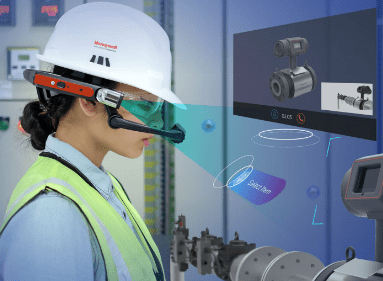Imagine this: In a manufacturing plant, workers can do picks without getting off their vehicles. They have a forklift they are driving, and they can get the next picking instruction while still driving because they can scan the barcode from a distance. Or what about this: Wind turbine workers can climb up and down and leave the laptop on the ground. At the same time, technology is self-documenting, and the reports are creating themselves. This is what the future of work will look like with the help of assisted-reality wearables for frontline workers.
Assisted reality is a non-immersive experience and has become a good solution for frontline industrial workers, especially where high situational awareness is necessary. Assisted reality experiences are closer to the physical world—when compared to VR (virtual reality) and AR (augmented reality) experiences that immerse workers in the metaverse.
Consider this example of assisted reality. In December, RealWear unveiled RealWear Navigator 500, which is the company’s industrial-strength wearable. Building on its flagship RealWear HMT-1 head-mounted display, RealWear Navigator 500 represents a new family of assisted reality products for RealWear, with a new modular platform, improved user experience, and comfortable ergonomics that empower frontline workers to perform work tasks while keeping these workers’ hands and fields of view free to perform tasks safely.
The safety aspect of this is perhaps one of the most impressive. Sanjay Jhawar, cofounder and chief strategy officer, RealWear, tells me there’s one display rather than two mounts to a hard hat, which means workers can easily get display out of the way. The technology doesn’t target a very broad field of view; rather it targets a field of view that allows workers to remain very much aware of surroundings, situationally aware for safety.
“So, we block less than 20%,” he explains. “We block about 20% of the naked eye view and leaving 80%, including all your peripheral vision intact. And that’s very important to the kind of customers that we serve, who are very focused on safety and situational awareness and compatibility with a very wide range of PPE from hard hats to climbing helmets, to bump caps, and safety glasses and respirating masks and military helmets. We can accommodate all those kinds of things. So that’s really the focus for RealWear.”
Productivity is also another huge benefit. Automotive, logistics, manufacturing, food and beverage, and energy companies, among others, can use RealWear Navigator 500 to deliver realtime access to online information and expertise to the world’s more than 100 million industrial frontline workers.
The user interface is predominantly based on voice recognition, uses a small amount of head motion, but it doesn’t use any hands at all. All the applications, all of the operating system, can be driven without hands. Another differentiator here is the technology is very rugged. Jhawar tells me he came from Sonim Technologies—as did some of the team—so it performs a six-foot-drop test and had a very small failure rate. “Usually, vendors don’t come out of the gate with that sort of reliability, but again many of us have done this before in a smartphone and feature phone space,” he says.
RealWear Navigator 500 combines hardware, software, and cloud-ready services with a rugged design that is one-third lighter and slimmer than the previous generation, making it easier for frontline workers to wear the device for their entire shift. The voice-controlled user interface includes unique noise-cancelation technology designed for high-noise environments. RealWear has more than 200 optimized partner apps supporting a variety of use cases, such as remote collaboration, guided workflow, and the IoT (Internet of Things) and AI (artificial intelligence) data visualization.
Jhawar points to the example of IBM’s inspector wearable, which is a computer vision application being used to do quality inspections in manufacturing and a number of industries, including automotive. As an example, a worker can look at the right figure or diagram in a manual in just a few seconds.
What makes this product unique is its ability to collect more than just data—it is also collecting context in its head-mounted device. As Jhawar says, it is very “intimate to the user.” The device always knows which way the worker is looking and is able to collect “contextual data necessary to understand where you are, what you’d like to do next, and what people like you did before you were here.”
Consider the example of Skanska’s crane operations. One of the big challenges is a worker needs to be up high in the cab of the crane. Now, with a combination of technologies from RealWear and Hewlett-Packard Enterprises, each worker on the ground can wear a device on their hard hat and have all of that video transmitted up to a tablet in the cab so that the person operating the crane could see the first-person view of each of the construction workers.
All in all, it gives much better awareness of what is happening so businesses can do operation faster while not compromising on safety. This is perhaps the type of innovation we need as we move ahead into 2022, and a new era of digital transformation.
Want to tweet about this article? Use hashtags #IoT #sustainability #AI #5G #cloud #edge #futureofwork #digitaltransformation #green #ecosystem #environmental #circularworld #wearable #assistedreality #wearable


